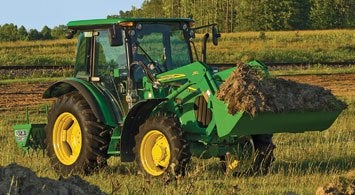
The John Deere 5M series utility tractor line up consists of seven models ranging from 65 to 105 horsepower. Designed as a replacement for the previous generation 5025 series, the new M tractors on average are 700 lbs heavier. Areas benefitting from the extra beef include the transmission housing, chassis, three-point hitch (3PH), axles, and loader mounting points. Manufactured in Augusta, Ga., 5M series tractors come with 5-cylinder 3.0 L engine (5065 and 5075) or 4-cylinder 4.5 L engine (5085, 5095 and 5105), both of which are turbocharged. Low profile and Hi-crop versions are also available.
The 5105M we tested was equipped with the series’ most powerful powerplant, a John Deere PowerTech E 4045 engine rated to deliver 105 gross horsepower at 2100 rpms. The 4.5 L engine outputs 90 horsepower at the power take off (PTO) and delivers 420 ft. lbs. of torque as low as 1400 rpm. The amount of cutting edge technology found in this powerplant could take up this entire review space, but suffice to say it comes with long life features such as a full pressure lubrication system that coats the underside of the pistons with cool, filtered oil, wet sleeve cylinder liners, and a heavy-duty block that is the basis of the tractor chassis and allows the tractor to perform in less than ideal conditions such as ditches and ravines.
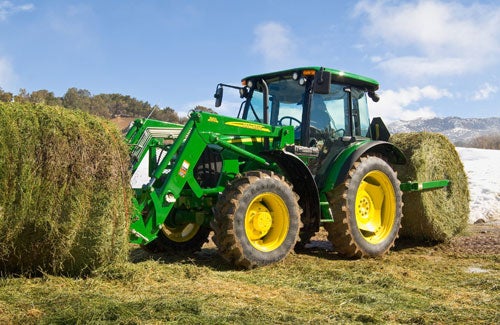 |
Vibration levels are extremely low due to the balanced crankshaft and heavy-duty components. And engine charge air is through an air-to-air aftercooler designed to meet emissions requirements and give the tractor better fuel economy. High Pressure Common Rail (HPCR) injection allows higher pressures (up to 23,000 psi) and combined with the Engine Control Unit (ECU) makes for lower combustion temperatures and less clatter and noise. The ECU also provides warnings or even complete system shut down to prevent more costly repairs. Data can be retrieved by commonly available diagnostic tools.
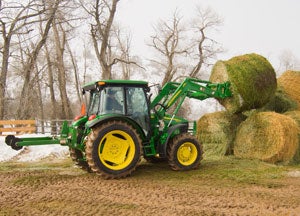
The 5105M hydraulic system is fed a whopping 24.7 gpm through a tandem pump sharing a single reservoir that makes available 6.3 gpm for power steering and 18.4 gpm for implement use. The design allows for triple rear selective control valves (SCV) and triple mid-mount hydraulics. Pump is variable in pressure to meet the highest demand, but the three-point hitch (3PH) gets priority so at the end of a pass the operator can raise the implement without having to turn remotes off. Rear SCVs are color coded as are the control levers. Our test tractor was equipped with optional triple rear deluxe hydraulics which give the operator more efficient options that include: no-detent where the cylinder works up/down like a loader or a top and tilt upper link; continuous flow for running a hydraulic motor; or kick-out where a cylinder completes a stroke and the SCV kicks out until actuated again.
There are three transmission options available: 12-speed forward/4-speed reverse; 16-speed forward/16-speed reverse; and 32-speed forward/16-speed reverse. A 2-speed creeper option is available on all three. Our test tractor was equipped with the 32F/16R Electrohydraulic PowrReverser transmission which allows clutchless transition from forward to reverse or reverse to forward. Checking off the Electrohydraulic option means you also get an Electrohydraulic 3PH, 540 rpm/540E rpm PTO and engage on the go 4WD (more on these options later).
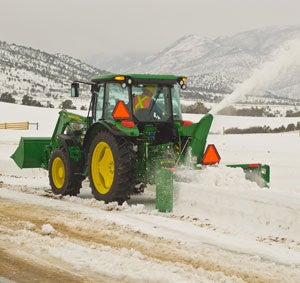
The Electrohydraulic PowrReverser transmission uses a small turn signal-like stalk on the left side of the steering column to change direction as has been used on forklifts and other commercial equipment for many years. The automatic internal clutching is wet hydraulic, which gives long system life and is highly desirable when there is more than one operator using the tractor.
On the left side of the gear shift lever (located near the operator’s right knee) there is a hi/low toggle switch that can vary forward speeds as much as 20%. This feature is especially helpful while doing tasks such as brush hogging where you might move from heavy brush to lighter and need to vary the ground speed. With the fingertip toggle, the speed is easily changed without having to clutch and change gears. A dash light indicator lets the operator know the status of the transmission.
Our test tractor was equipped with a John Deere climate controlled cab. The cab is roll over protection system (ROPS) certified and adds a whopping 1100 lbs to the tractor weight. The cab has two doors that open wide with cleated steps on both sides. The glass is tempered and sealed with automotive quality and precision. Slide into the deluxe fabric seat (an air ride seat is available) and the operator is treated to fore/aft, up/down and back rest angle adjustments along with a weight adjustment that goes from 100 to 275 lbs. Arm rests are standard as is a retractable seatbelt.
The cab control panel is on the upper right and the air conditioning is also out of the way so the operator has excellent visibility of the loader bucket from the ground to full lift height. The steering wheel tilts and telescopes. To the operator’s right is a console that houses the majority of control buttons and levers. The hand throttle (there is also a convenient foot throttle), SCVs, PTO engagement and 3PH controls are all located on this console.
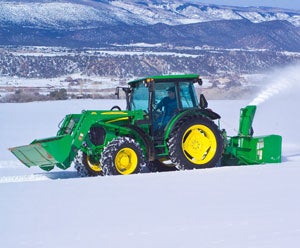
Quiet is the word for this work setup and we measured the cabin at 80-81 dBA (2100 rpm) which is the volume of an alarm clock or garbage disposal. A sun visor, dome light, front wiper and washer (rear is an option), debris deflectors, and full light/signal package are standard. The side windows open forward and the rear opens 70 degrees for better visibility when hooking up a 3PH implement. Wiring and speakers are in place should you wish to add a radio. The pedals are also noteworthy and are suspended, increasing the floorboard area. Nice.
Start up the 5105M and you can barely hear the idle from the vertical exhaust stack. Though the clutch isn’t required to shift from forward to reverse, the operator must initially depress it before shifting into gear. Deere does this as a safety check so the operator has time to focus on the tractor and task before starting off. Transport speed can be as high as 24 mph with the 32F/16R transmission, so you can really productively move from field to field.
Our testers felt right at home with the rear hydraulic controls on the right console, and the mid hydraulic controls actuated by the right side joystick. Mechanical front-wheel drive (MFWD) is engaged/disengaged by a dash-mounted toggle on the opposite side from the five-position light and flasher/turn signal switch. Differential lock is standard. Full 540 rpm PTO power is reached at 2100 rpm, though in these days of $3.00+ diesel fuel, many will select the 540E option which is reached at 1645 rpm. The tank holds 38 gallons (29 for open station tractors) so users selecting the 455 lesser rpm when possible will see the savings add up. Up to 20% biofuel (B20) is acceptable.
The 3PH on the 5105M comes with adjustable draft sensing. This allows the hitch to rapidly raise or lower in response to changing conditions and control engine load. It also reduces the need to downshift when going through a rough spot. We found the action to be smooth and accurate and when an adjustment needs to be made, sensing can be changed on the go. Telescoping lower 3PH arms are a factory option. The outside sway bars adjust with easy-to-use pin locks. As mentioned earlier, our test tractor came with every Electrohydraulic option, including the 3PH. When so outfitted, this system allows fine ¼” (5mm) adjustments and has thumb operated raise/lower buttons. A flip-up cover exposes rate of drop and hitch lift control knobs. Hitch lift is especially useful when using PTO-driven implements where it helps prevent the drive shaft from binding. A knob numbered from 1-5 controls the draft sensing sensitivity. The 3PH also can be controlled outside the cab from the left rear fender where there are switches to raise and lower the hitch to make hooking up an attachment easier. Lift capacity with the Electrohydraulic 3PH is rated at 4498 lbs 24” behind hitch balls. At the hitch ball the lift capacity is 6178 lbs.
John Deere has designed the 5M tractors for easy maintenance. The hood is one piece and there are no screens to remove or lose. Engine oil service interval is 300 hours, but if you go with John Deere Torq-Gard Supreme Plus 50, the interval stretches to 450 hrs. Air is filtered through a two-stage system with a restriction indicator light on the dashboard. The automotive style V-belt driving the fan, pump and alternator has a self-adjusting tensioner. If you run the 5105M out of fuel, the system isn’t self-bleeding, though there is a hand primer at the fuel filter which has a water and sediment bowl. A cold weather 110V block heater is available.
The 5105M rides on an 85.6” wheelbase, weighs 8400 lbs. in the cab variant and the axles clear 17.9”. Turning radius using brakes is 11.6’ (13.9’ without). Our test tractor was equipped with 12.4R24 R1 front tires and 480/80R30 R1W rear, but there are many tire options available. This is also an area a potential purchaser should discus with his/her dealer as the pairing with the MFWD is critical to driveline life.
If you are in the market for a 100+ horsepower cab tractor, check out the 5105M. Should you decide to purchase one and select the air ride seat, drop us a line and let us know how cushy that option turned out to be.
Related Reading
2012 Kioti DK45SE HST Cab Review
2012 Case IH Farmall 75C Cab Tractor Review
2012 Mahindra 5010 HST Cab Review
 Your Privacy Choices
Your Privacy Choices